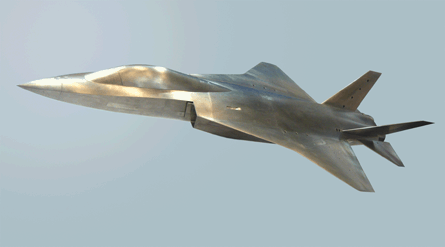India's Aeronautical Development Agency (ADA) has begun talks with the Indian air force to involve the service in the design for its proposed medium combat aircraft (MCA), and hopes to put forward a plan in a few years to secure government funding for detailed studies.
"In India, we have a fighter aircraft design team that comprises officials from various departments. It was formed to work on the Tejas light combat aircraft, and it makes sense for them to move on to a new fighter design after completing that," says P S Subramanyam, programme director (combat aircraft) at the ADA, which oversees design and development of the Tejas. "We are engaging the air force on the MCA and finding out about their requirements."
The agency, which displayed a windtunnel testing model of the MCA at the Aero India 2009 show in Bangalore in February, believes it will take 10 years to develop the aircraft. It also released further details on the twin-engine design, which will incorporate stealth features.
 |
|---|
© Siva Govindasamy/Flight International |
Primarily, the MCA will have air-to-ground and air-to-air capabilities and be able to perform suppression of enemy air defence, precision strike and close combat missions, the ADA says. The 20t design will also have a low radar cross-section, "serpentine-shaped" air intakes, internal weapons bays and advanced radomes to increase its stealth features. Radar-absorbing composites and paints will supplement the design, and there will also be an on-board micro-electro-mechanical system.
The MCA will use an advanced version of the indigenous Gas Turbine Research Establishment Kaveri engine, which is still under development, and is projected to deliver "supercruise" performance, thrust-vectoring control and low infrared capabilities, and a projected top speed of Mach 1.6.
It will also include integrated modular architecture avionics and data fusion sensor capabilities, plus a decision support system, advanced sensors, flush/body conformal antennas and pods, and advanced communication and net-centric warfare capabilities, the ADA adds.
The aircraft will further have the capability for internal weapon release in supersonic flight, high asymmetry control, and a reconfigurable flight-control system.
Subramanyam says that the MCA will not compete with the fighter that India selects for its medium multirole combat aircraft (MMRCA) competition. New Delhi is holding a tender to select 126 fighters for the requirement, with a selection projected to take place in 2010 and deliveries scheduled to begin from 2013. Contenders are the Boeing F/A-18E/F Super Hornet, Dassault Rafale, Eurofighter Typhoon, Lockheed Martin F-16, RSK MiG-35 and Saab Gripen.
"The MMRCA aircraft are fourth-generation fighters that are already in production and incorporating technology that is already available. The MCA will replace the air force's existing MiG-29s and [Dassault] Mirages when those are retired over a decade from now," Subramanyam says. "It is being conceptualised now to use technology that will be available only 10 years from now, and so will be very different and have superior capabilities to the current generation of fighters."
Source: Flight International



















